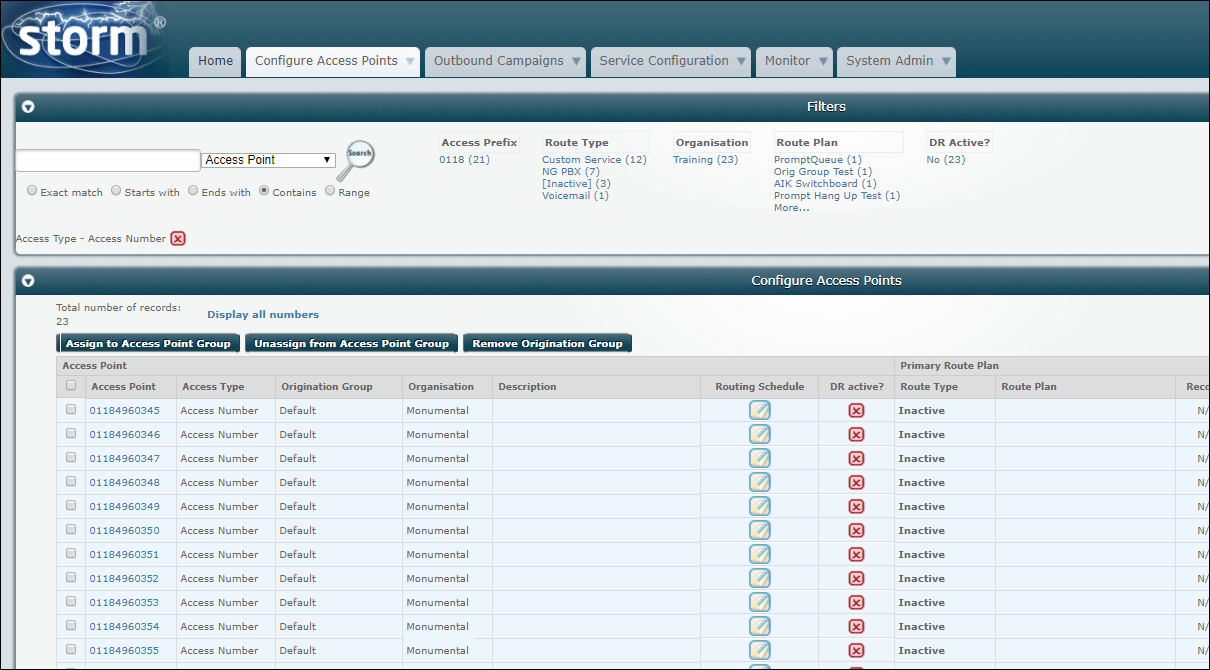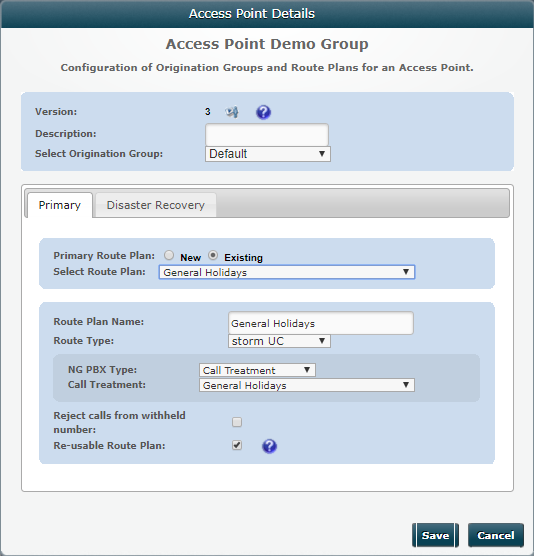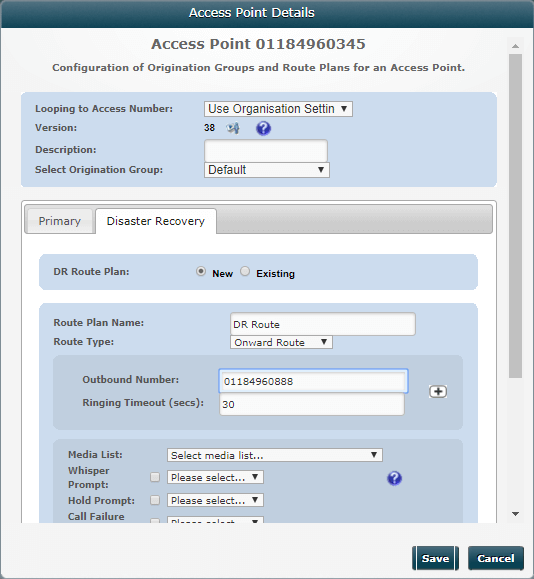
Configure Main Routing on an Access Point
This section describes how to configure primary and disaster recovery routing. Primary routing refers to the normal routing that takes place at most times. Disaster recovery routing refers to routing that overrides the primary and any scheduled routing when the disaster recovery switch is active.

|
Parameter |
Description |
|
Route Plan Name |
Provide a meaningful description for the route plan. |
|
For social media channels, the route type must be 'Custom Service' and the target service must use a FLOW script that routes to a queue treatment. The FLOW script can then be used to determine the importance of an incoming communication based on, for example, how many followers the originating account has or on whether the communication involves a very good or very poor review. Messages that require a response can then be routed to a queue that presents them automatically to the next available agent for attention, while messages of lower priority can be routed to a queue where they wait for an agent to select (cherry pick) and process them manually. Routes voice calls to a telephone number. Enter a number in the Outbound Number field and edit the ringing timeout if desired. Click Media List: The custom media list containing the audio prompts. Whisper Prompt: Select the check box and then the audio to play to the called user. Hold Prompt: Select the check box and then the audio to play to the caller as they connect (replaces the ringing tone). Call Failure Prompt: Select the check box and then the audio to play to the caller on connection failure. If voicemail is not activated, the call drops following the audio. Recording: Select this to activate call recording for calls using this route plan. Voicemail: Select this to divert the caller to a voicemail deposit service once all onward route destinations have been tried without success. You will need to select a preconfigured voicemail profile of mailbox settings. Queueing: Select this to place callers on hold until one of your defined onward route destinations becomes available. Callers will hear the hold prompt. Define the queuing time if desired. Withhold CLI: Select this to withhold the caller's CLI. If set, a default CLI set by Content Guru is displayed to the user. Routes voice calls to a SIP trunk. Depending on your implementation, each name could refer to a connection to a particular site, a specific PBX, or a data centre. The SIP trunks must be configured by your supplier. Select the SIP trunk and configure the following options: Pass through access number as outbound number: Select this if the destination PBX or gateway is configured to recognise the access number. Otherwise, leave the check box and enter the appropriate number in the Outbound Number field. Ringing Timeout: The number of seconds for which to try calling on the SIP trunk. Media List: The media list containing the audio whisper prompt. Whisper Prompt: Select the check box and then the audio to play to the called party. Recording: Select this to activate call recording for calls using this route plan. Voicemail: Select this to divert the caller to a voicemail deposit service once all SIP Trunk destinations have been tried without success. You will need to select a preconfigured voicemail profile of mailbox settings. Routes communications using a predefined Auto Attendant IVR service or a FLOW script. Select the target service. Route communications to a predefined UC element, which can be a treatment (such as a hunt group or a queue), a user, or the UC voicemail retrieval system. Select the target treatment or user if routing to those. For voicemail, callers can access UC mailboxes configured at user, treatment, and organisation level by entering a valid extension and PIN. Route voice calls to voicemail for depositing or retrieving a message. You must select a preconfigured voicemail profile of mailbox settings. Plays an audio prompt to the caller. Select the desired audio file from a media list. Once the prompt has played, the call terminates Route voice calls to two or more destinations or services, based on a percentage weighting. Select a preconfigured percentage split profile (this defines the weighting). |
|
|
Reject calls from withheld numbers |
Where applicable, select the check box to reject communications in which the originating number, account or email address has been withheld. |
|
Re-useable Route Plan |
Clear the check box if you do not want the route plan to be saved for assignment to other access numbers. |
Assigning Route Plans to an Access Point
This section describes how to assign route plans for primary and disaster recovery routing

This displays a list of access points that is
filtered to display access numbers only. You can click the  button next to Access
Type - Access Number to remove the filter and see all access points.
button next to Access
Type - Access Number to remove the filter and see all access points.

|
Parameter |
Description |
|
Description |
Provide a meaningful description for the access point. For example, 'Main IVR number'. |
|
Select Origination Group |
Applies to an access point of type telephone number, SMS short code or long code, and email address Select an origination group (if configured) to route incoming communication from only those numbers or addresses in the group. |

Note: by selecting the New option, you can create a new route plan directly on the access point. The new plan is saved to your list of route plans

Note: to remove a route plan assignment from an access point/group, click on the access point/group and then, on the appropriate tab of the dialog, select New for the route plan. Wait while the tab loads and then click Save.
Click the  toggle button in the DR active column for the access point or access point group. It changes to
toggle button in the DR active column for the access point or access point group. It changes to  indicating that communications to this access point/group will be routed according to the assigned route plan for disaster recovery. Clicking
indicating that communications to this access point/group will be routed according to the assigned route plan for disaster recovery. Clicking  reverts to primary routing.
reverts to primary routing.
